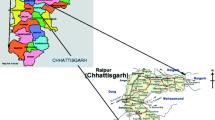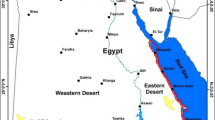Abstract
Spatial variations in the relationship between topography and mean annual and seasonal rainfalls in southwestern Saudi Arabia are examined using Kruskal–Wallis one-way analysis of variance. The topographic factors include physiographic features (topography), altitude, slope, proximity to a ridge or crest of mountains, and proximity to the Red Sea. There is a statistically significant effect of topographic factors on the mean annual rainfall, but the results are more significant for the mean seasonal rainfall. The largest amount of mean rainfall in the study area occurs during spring, when rainfall displays a significant relationship with topographic factors, in which more orographic rainfall patterns are associated with higher altitude, greater proximity to a ridge and steeper slopes. Higher altitudes do not necessarily receive more rain; some low altitude locations (i.e., the southern part of the study area) receive more rain during summer and fall because they are located on the windward side of the Asir Mountains and are exposed to the moist air masses brought by the southwest monsoonal system in summer and by the northwest air flow from the Mediterranean and Red Sea in the fall in addition to local convective rainfall patterns. Rainfall in winter increases in the foothills of the Asir Mountains above the coastal plain of the Red Sea. The steep western slopes (windward side) receive more rainfall than the gentle eastern slopes (leeward side): this may be due to the Asir Mountains forcing moist air masses carried by the westerly and northwest winds to rise and cool before they descend and warm on the leeward side.










Similar content being viewed by others
References
Abdullah MA, Al-Mazroui MA (1998) Climatological study of the southwestern region of Saudi Arabia, I. Rainfall analysis. Clim Res 9:213–223
Abdulrazzak MJ, Sorman AU, Onder H, Al-Sari AM (1995) Flood estimation and impact: southwestern region of Saudi Arabia. Final report for project No. AR-10-51, KACST, KSA, Riyadh
Alijani B (2008) Effect of the Zagros Mountains on the spatial distribution of precipitation. J Mater Sci 5:218–231
Alyamani MS (2001) Isotopic composition of rainfall and ground water recharge in the western province of Saudi Arabia. J Arid Environ 49:751–760
Alyamani MS, Sen Z (1993) Regional variations of monthly rainfall amounts in the Kingdom of Saudi Arabia. JKAU Earth and Sci 6:113–133
ASTER GDEM (2010) ASTER Global Digital Elevation Model (ASTER GDEM). http://www.jspacesystems.or.jp/ersdac/GDEM/E/
Basist A, Bell GD (1994) Statistical relationships between topography and precipitation patterns. J Climate 7:1305–1315
Buytaert W, Celleri R, Willems P, Bievre BD, Wyseure G (2006) Spatial and temporal rainfall variability in mountainous areas: a case study from the south Ecuadorian Andes. J Hydrol 329(3–4):413–421
Chan Y, Walmsley RP (1997) Learning and understanding the Kruskal–Wallis one-way analysis of variance by ranks test for differences among three or more independent groups. Phys Ther 77(12):1755–1762
Daily C, Neilson RP, Phillips DL (1994) A statistical–topographic model for mapping climatological precipitation over mountainous terrain. J Appl Meteorol 33:140–158
Diodato N (2005) The influence of topographic covariables on the spatial variability of precipitation over small regions of complex terrain. Int J Climatol 25:351–363
Drogue G, Humbert J, Deraisme J, Mahr N, Freslon N (2002) A statistical topographic model using an omnidirectional parameterization of the relief for mapping orographic rainfall. Int J Climatol 22:599–613
Dunn OJ (1964) Multiple comparisons using rank sums. Technometrics 6:241–241
Field A (2000) Discovering statistics using SPSS for windows: advanced techniques for beginners. Sage, London
Gouvas M, Sakellariou N, Xystrakis F (2009) The relationship between altitude of meteorological stations and average monthly and annual precipitation. Stud Geophys Geod 10:557–570
Hayward D, Clarke RT (1996) Relationship between rainfall, altitude, and distance from the sea in the Freetown Peninsula, Sierra Leone. J Hydrol Sci 41(3):377–384
Hutjes R, Maat H, Bisselink B, Ohba R, Ueda H (2005) Meteorological impact assessment of possible large scale irrigation in South West Saudi Arabia. 3rd EU Japan meeting
Johansson B, Chen D (2003) The influence of wind and topography on precipitation distribution in Sweden: statistical analysis and modeling. Int J Climatol 23:1523–1535
Johnson GL, Hanson CL (1995) Topographic and atmospheric influences on precipitation variability over a mountainous watershed. J Appl Meteorol 34:66–87
Konrad CE (1996) Relationship between precipitation event types and topography in the southern Blue Ridge Mountains of the southeastern USA. Int J Climatol 16:49–62
Kruskal WH, Wallis WA (1952) Use of ranks in one-criterion variance analysis. J Amer Statist Assn 47(260):583–621
Kyriakidis PC, Kim J, Miller NL (2001) Geostatistical mapping of precipitation from rain gauge data using atmospheric and terrain characteristics. J Appl Meteorol 40(11):1855–1877
Marascuilo LA, Serlin RC (1988) Statistical methods for the social and behavioral sciences. W.H. Freeman & Company, New York
Naoum S, Tsanis IK (2004a) A multiple linear regression GIS module using spatial variables to model orographic rainfall. J Hydroinform 6(1):39–56
Naoum S, Tsanis IK (2004b) Orographic precipitation modeling with multiple linear regression. J Hydrol Eng 9:79–102
Ninyerola M, Pons X, Roure JM (2000) A methodological approach of climatological modeling of air temperature and precipitation through GIS techniques. Int J Climatol 20:1823–1841
Nouh M (1987) Point rainfall distribution in the southwest of Saudi Arabia. J Eng Sci KSU 13(1):321–328
Oettli P, Camberlin P (2005) Influence of topography on monthly rainfall distribution over East Africa. J Clim Res 28:199–122
Prudhomme C, Reed DW (1998) Relationships between extreme daily precipitation and topography in a mountainous region. Int J Climatol 18:1439–1453
Prudhomme C, Reed DW (1999) Mapping extreme rainfall in a mountainous region using geostatistical techniques. Int J Climatol 19:1337–1356
Sen Z (1983) Hydrology of Saudi Arabia. Symposium on Water Resources in Saudi Arabia A68–A94, Sci Pub Cen, KSU, Riyadh, Saudi Arabia
Sen Z, Al-Subai K (2002) Hydrological considerations for dam siting in arid regions: a Saudi Arabian study. Hydrol Sci J 47(2):173–186
Sevruk B (1997) Regional dependency of precipitation–altitude relationship in the Swiss Alps. J Clim Chan 36:355–369
Sevruk B, Sadlonova KM, Toskano L (1998) Topography effects on small scale precipitation variability in the Swiss pre-Alps. J Int Ass Hydrol Sci 248:51–58
Subyani AM (1999) Topographic and seasonal influences on precipitation variability in southwest Saudi Arabia. J KAU Earth and Sci 11:89–102
Subyani AM, Al-Dakheel AM (2009) Multivariate geostatistical methods of mean annual and seasonal rainfall in southwest Saudi Arabia. Arab J Geosci 2(1):19–27
Subyani AM, Al-Modayan AA, Al-Ahmadi FS (2010) Topographic, seasonal, and aridity influences on rainfall variability in western Saudi Arabia. J Environ Hydrol 18(12)
Wheater HS, Butler AP, Stewart EJ, Hamilton GS (1991) A multivariate spatial–temporal model of rainfall in southwest Saudi Arabia, I. Spatial rainfall characteristics and model formulation. J Hydrol 125:175–199
Williams F (1991) Reasoning with statistics: How to read quantitative research. Fourth edition. Holt, Rinehart and Winston
World Meteorological Organization (1967) A note on climatological normals. Technical note 84, WMO-208
Acknowledgment
We are thankful to King Abdulaziz City for Science and Technology (KACST) for the accomplishment of this project.
Author information
Authors and Affiliations
Corresponding author
Rights and permissions
About this article
Cite this article
Al-Ahmadi, K., Al-Ahmadi, S. Spatiotemporal variations in rainfall–topographic relationships in southwestern Saudi Arabia. Arab J Geosci 7, 3309–3324 (2014). https://doi.org/10.1007/s12517-013-1009-z
Received:
Accepted:
Published:
Issue Date:
DOI: https://doi.org/10.1007/s12517-013-1009-z




